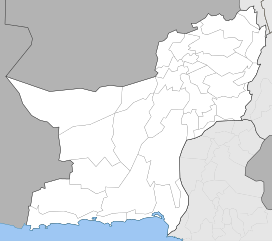Chagai Hills
| Chagai Hills | |
|---|---|
 Chagai Hills (Balochistan, Pakistan) | |
| Geography | |
| Location | Afghanistan-Pakistan border |
| Range coordinates | 29°19′35.65″N 64°6′17.26″E / 29.3265694°N 64.1047944°ECoordinates: 29°19′35.65″N 64°6′17.26″E / 29.3265694°N 64.1047944°E |
The Chagai Hills is a range of granite hills in the Chagai District in Pakistan's Balochistan province.
Location
The Chagai Hills lie between 28' 46" to 29' 34" N and 63' 18" to 64' 50"[1] in a desert area in the northernmost part of Chagai District north of Pakistan's Ras Koh Hills and south of Afghanistan's Helmand and Nimruz provinces.
Topography
The Chagai Hills are granite mountains, which, at their highest point, rise to a height of 9,367 ft (3,009m) above sea level. They stretch over an area that is approximately 175 km in length and 95 km in width.
Climate
Chagai Hills lie in an arid zone, which is outside the main monsoon belt. The Chagai Hills receive an average of 4 inches (102 mm) annually. The temperature is extreme: very hot in summer and very cold in winter. The average minimum temperature is 2.4 °C (36.3 °F) in January and the average maximum temperature is 42.5 °C (108.5 °F) in July.[2]
Nuclear tests
Chagai Hills were not the location of Pakistan's Chagai-I nuclear tests of 28 May 1998, which were at the Ras Koh Hills, an entirely different range of hills to the south of Chagai Hills, separated from the Chagai Hills by a large valley. However, confusion may arise because widespread reporting prior to the actual explosion mentioned the Chagai Hills region, and because both the Chagai Hills and the Ras Koh Hills are situated in the Chagai District.[2][3]
References
- ↑ Ralph Buller; Hughes-Buller (1908). Imperial gazetteer of India: Provincial Series: Baluchistan. Superintendent of government printing. p. 94. Retrieved 28 April 2017.
- 1 2 http://www.pakwatan.com/travel_detail.php?pageNum_rsNews=2&totalRows_rsNews=42&id=19
- ↑ http://www.globalsecurity.org/wmd/world/pakistan/chagai.htm
